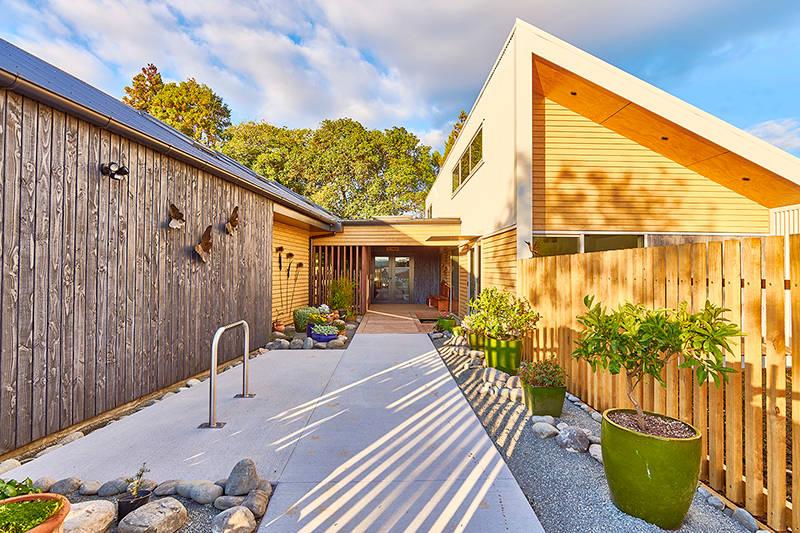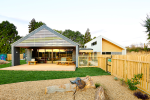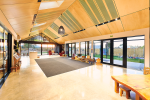Te Puna Kindergarten

When mod Architecture’s Andrew Ward heard that his son’s kindergarten would have to move, he offered to investigate options for a new building.
The move came about because Inspired Kindergartens’ Te Puna Kindergarten, outside Tauranga, had its site acquired by NZTA for a major road redevelopment.
As Andrew explains, “There was some talk about moving the old building to a new site but it was a bit rundown and needed maintenance so I put my hand up and said I would look at a design and some building sites on a pro bono basis.”
“Having a son there gave me some insight into how the kindy operated and how the staff ran the place so I could use that to come up with the right plans for them. The site that Inspired Kindergartens found and I evaluated was just down the road so I did some plans pro bono and some costings and they went with it.”
He adds, “The brief from the staff was from a teaching perspective and they wanted something practical and not gimmicky or overly modern – something that fitted in with the landscape. They also wanted the interiors to be something of a blank canvas because they wanted the children’s artwork to be the decoration.”
That partnership obviously worked as the project was recently named Winner in the Education category at the Waikato/Bay of Plenty awards for the Te Kahui Whaihanga New Zealand Institute of Architects.
The award judges said, “This joyful kindergarten is made up of two strong building forms that provide a clear and confident entry from a busy car park. Its contemporary shed-like appearance gives a nod to its rural neighbours. Inside, generous, light-filled spaces comprise a sociable and welcoming learning environment that is easily navigated at play time and rush hour by small people, teachers, and caregivers. Te Puna Kindergarten is an asset to future generations, creating a practical and playful space for tamariki that delights and inspires.”
As it happened, the site that the kindergarten settled on neighboured that of the farmer who had donated the original site for the kindy.
Andrew says, “It borders on to rural land and the landowner there, as well as donating the original land for the kindergarten, has been heavily involved with the kindergarten for the past 20 years. So we ended up making a little gate through to his land so the kids can go into the orchard and enjoy tractor rides and things like that.”
He says the barn-like shape of the kindergarten building and its corrugate roofing and rough sawn timber helps it to sit comfortably in that rural setting.
“The corrugated iron not only gives you that rural feel but also it’s easy to maintain and provides a design element.”
A central spine that acts as an entranceway separates this gabled building from a second pavilion, which comprises adult toilets, office space and a meeting room that can be used by community groups after hours.
The design means northern light can enter the southern, mono-pitch pavilion while also providing a clear delineation between the areas for the children and the adults.
The two pavilions are also delineated by their materials, with darker cladding and roofing on the kindergarten building and lighter roofing and cladding on the mono-pitch pavilion.
The layout of the open plan kindergarten has a kitchen at the western end where kids do baking, a main activity area sits centrally, and at the eastern end is an arts area, with the child toilets off to one side.
“The toilets were a tricky one,” says Andrew, “because you have to give the children privacy but the teachers need to be able to monitor them.”
The kindergarten sits on a highly insulated concrete raft slab thermal mass that stores heat gained from the northern aspect with the roofline creating optimal absorption of sunlight in winter and shade in summer.
A pergola on the northern side creates a room without walls and sense of space, and slatting could be added to it to create shading if there was too much solar gain from that side of the building. The north-facing roof plane was pre-wired for solar panel installation, and this was installed at a later date.
Ventilating skylights allow heat to escape in summer and let in light. End-to-end opening windows and doors allow for natural ventilation.
The plasterboard walls and fire-safe plywood ceilings have acoustic treatment to keep the noise levels of excited pre-schoolers down.
“The plywood on the ceilings gives an exposed timber feel for that rural feeling, and I played with the proportions and patterns of the lighting and acoustic tiles using blocks and stripes so that when you look at the whole ceiling it has a nice rhythm to it.”
Materials were carefully selected by Andrew for their non-toxic, chemical-free, low VOC (volatile organic compounds), sustainability and end of life properties to ensure the structure was as sustainable, safe and as chemical-free as possible.
The New Zealand plantation Douglas Fir heartwood Abodo timber cladding is naturally durable and contains no wood preservatives. A similar thought process applied to the decks with chemical-free, heat-treated plantation pine where children directly interact. This wood product carries Forest Stewardship Council Certification and does not contain arsenic, a common preservative for exterior timber.
An open gable at the western end provides a space where children can have lunch. Slatting has been used on this end to stop afternoon sun entering and also as protection from rain for the outdoor seating.
Andrew had some fun decorating the slatting, which has a pattern that can be seen from a distance and represents rolling countryside and sky.
The design presented Andrew with some challenges and personal investment.
“My older son had left by the time it was built but I had a younger son go there before he went off to school so it was quite nice to be involved with a project that I also used.”
mod Architecture
Andrew Ward has over 20 years of experience both in New Zealand and abroad and has worked on all genres of architecture including residential, multi storey, mixed use, hospitality, education, office fit-out and government departments.
In 2008 Andrew founded mod Architecture as a boutique architectural design company based in Tauranga.
As the company has grown it has begun specialising in contemporary, modern, bespoke residential architecture. A key focus on the old adage ‘form follows function’ is evident in its designs.
mod Architecture is dedicated to simple and honest architecture. Through clever detailing and material choice this does not need to be expensive – elegance and economy can co-exist.
The firm follows these principles: design for the client and the landscape, produce timeless design that comes from simplicity and proportion, and be innovative – architecturally, structurally and functionally


